Written by Tory Schmidt, Tree Fruit Research Commission, June 22, 2018
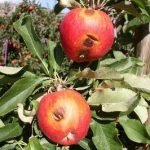
Even though conditions have been relatively moderate most of this spring, the long, hot days of summer are coming. It is time for apple growers to make sure they have their plans to protect their fruit from sunburn ready to go. While it is possible for juvenile fruitlets to develop necrotic lesions from excessive heat and light exposure during May, most growers are either unaware or don’t worry about these damaged fruits because they usually slough off during June drop. By this time of year, however, most apple trees have settled on their final crop load and it is now up to the growers to protect the fruit that remains.
Sunburn remains the leading cause of apple cullage and reduced packouts in Washington, in some years accounting for more than half of all off-grade fruit. Much of our understanding of sunburn in Washington apples is rooted in the outstanding research of retired WSU professor Larry Schrader and the students and staff who worked in his lab.
They describe the following major categories of sunburn:
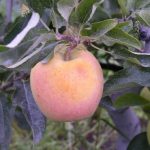
Sunburn necrosis is dramatic in appearance and caused by excessive heat and occurs as fruit tissue cells die when their temperature reaches approximately 126°F. Under calm wind conditions, fruit surfaces can be up to 30°F hotter than the surrounding air, meaning necrosis can occur on days with temperatures in the 90s.
Sunburn browning is the most prevalent and costly expression of sunburn in WA; it is a function of both light and temperature and typically occurs when fruit surface temperatures reach 114-120°F for approximately one hour, causing degradation of cellular membranes. The threshold temperature is cultivar-specific, with some varieties being more sensitive (e.g. Honeycrisp, Cripps Pink) than others (e.g. Red Delicious, Braeburn). The conditions that contribute to sunburn browning are very similar to those known to contribute to “delayed” or “storage” sunburn, where fruit that look clean going into storage come out months later with discoloration that can cause significant amounts of costly downgrading.
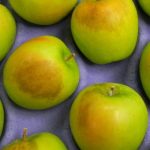
Finally, photo-oxidative sunburn can occur at low temperatures when fruit which has not been acclimatized to intense light is suddenly exposed to full sun (a la sunburn of human skin). This can be expressed initially as bleaching and eventually darkening of the fruit peel. This type of damage is most commonly seen when summer pruning or tree training suddenly exposes previously shaded fruit, or at harvest when in fruit on the top layer of a bin left out in full sunlight.
Horticultural management techniques for sunburn
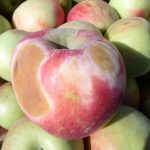
Overhead or evaporative cooling (EC) remains one of the most effective options for reducing sunburn symptoms. Many people incorrectly believe that EC works because fruit surfaces are cooled by direct application of cold water. While this effect can help, the main benefit of EC is the reduction of air temperature due to the heat of vaporization of water (remember your high school physics class?). Essentially, latent heat is pulled from air, leaves, fruit, etc. to provide the energy required for water to evaporate. The principle is the same for the use of patio misters, sweating, or the chill you might feel from wearing wet clothes on a breezy day.
While EC is reliable, it requires significant investment to install, maintain, and operate a cooling system in orchard blocks. Programmable timers and electric valves may reduce labor costs related to manually opening and closing a set of valves every 10-20 minutes, but these systems still need to be monitored to ensure they’re functioning properly. Another major limitation for some operations is the availability of adequate water during times of peak demand. Even if abundant water is available for EC, growers should be aware of possible concerns regarding food safety, hard water stains on their fruit, and potential rootzone flooding and the resulting anaerobic conditions in soils which drain poorly. (And this year for fire blight spread).
Protective Netting
In large part due to these concerns with EC, protective netting seems to be becoming a popular option for sunburn protection in our industry with each passing year. The up-front costs for installing netting systems can be significant, particularly if a block’s trellis needs to be retro-fitted or re-engineered to accommodate the additional load created by the net. There is also a significant learning curve regarding the seasonal deployment and removal of nets, but most growers report major gains in labor efficiency after they have been through the process a few times.
The cost-effectiveness of nets would be marginal for most operations if their only benefit was to reduce sunburn symptoms, but of course, nets can also reduce cullage due to wind damage, hail, and in the case of cherries, rain. Closed netting structures clearly reduce bird damage and have been shown to significantly retard the infestation of some invasive pests like Brown Marmorated Stink Bug. Further, the use of different colors of nets can influence shoot growth, fruit color, and fruit quality. https://www.goodfruit.com/net-benefits/
Sprayable Protectants
Finally, the third major sunburn management technique is the use of sprayable protectants. This option can be quite useful for spot-treating or during periods of extreme heat when blocks not normally prone to sunburn need some extra protection. When properly applied, most sprayable products can reduce cullage due to sunburn by up to 50%. These materials need to be re-applied throughout the summer to maintain coverage and protect newly exposed surface area as fruit continue to grow; the frequency of re-application depends on the specific product, weathering conditions (namely wind and precipitation), and the amount of sunburn pressure, but most products should have maintenance sprays every 2-4 weeks. There are currently three major categories of sunburn protectants available on the market:
- Kaolin clays (i.e. Surround): these products reflect light and heat off the fruit surface and can have some benefits for pest control, particularly pear psylla; they can be challenging to clean up on the packing line, particularly in fruit stem bowls, so growers should consult with their warehouse before using these products close to harvest
- Calcium carbonates (i.e. Eclipse, PurShade, etc.): there are many products in this category which also reflect/scatter heat and light from fruit surfaces; they tend not to be as tenacious as kaolin products, so they may require more frequent applications, but are also easier to clean up at harvest; this form of calcium is not very soluble and therefore has little nutritional value to the tree or fruit
- Lipophilic waxy matrices (i.e. Raynox): these clear coatings are not readily visible on the fruit surface, meaning they generally don’t present any cleanup issues at harvest. These materials reduce the effects of harmful UV-B light on apple fruit. Unlike most other sprayable protectants, Raynox can be used in combination with evaporative cooling, which has been shown to reduce sunburn incidence by up to 95% in some studies
We are blessed with abundant light and heat to grow high yields of quality apples in Washington, but as with many other things in life, too much of a good thing can cause problems. Fortunately, growers have a number of tools at their disposal to protect their fruit from sunburn.
Contact
Project Manager
Washington Tree Fruit Research Commission
1719 Springwater Ave.
Wenatchee, WA 98801 USA
Office: (509) 665-8271 x4
Mobile: (509) 669-3903
Email: tory@treefruitresearch.com
Web: www.treefruitresearch.com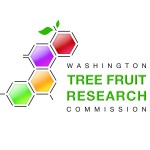
Fruit Matters articles may only be republished with prior author permission © Washington State University. Reprint articles with permission must include: Originally published by Washington State Tree Fruit Extension Fruit Matters at treefruit.wsu.edu and a link to the original article.
